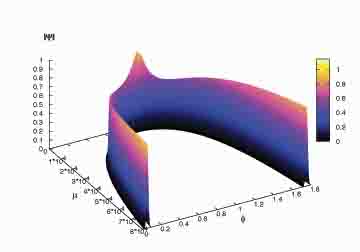نظریه سی پی اچ بر اساس تعمیم سرعت نور از انرژی به ماده بنا شده است.
سی پی اچ در ژورنالها
|
عالم پیش از تولد دیده شد
|
|
نسبیت عام میتواند عالمی را توصیف کند که به عقب برمیگردد و ماده آنقدر چگال میشود که معادلات قادر به جوابگویی نیستند. از آن پس باید از ابزار های کوانتومی بهره جست که در زمان اینشتین در اختیارش نبودند. با ترکیب فيزيك كوانتومي و نسبيت عام مدلي بدست مي آيد كه از بيگ بنگ به دنياي ميرسد كه فيزيك آن براي ما شناخته شده است. تيم محققان در گزارش ارسالي خود به Physical Review Letters نشان دادند كه قبل از بيگ بنگ دنيايي در حال انقباض وجود داشته كه فضا-زمان آن شبيه عالم كنوني در حال انبساط ماست. درحاليكه نيروهاي گرانشي، آن دنياي قبلي را به درون ميفشردند به نقطه اي رسيدند كه خواص كوانتومي فضا-زمان گرانش را از جاذبه به دافعه تبديل كرد، و انفجار بزرگ رخ داد !
برای مطالعه بیشتر سياهچاله مطلق را نیز ببینید
Researchers Look Beyond the Birth of the Universe
The figure represents our expanding universe as the right branch of the arc. Our time now is located at the 1.8 grid mark on the right side of the drawing. According to Ashtekar's team's calculations, when looking backward throughout the history of the universe, 'time' does not go to the point of the Big Bang but bounces to the left branch of the drawing, which describes a contracting universe. Singh explains, "The state of the universe depicted by its wavefunction is shown in space (\mu) and time(\phi). The big bang singularity lies where space vanishes (goes to zero). Our expanding phase of the universe is shown by the right branch which, when reversed backward in time, bounces near the Big Bang to a contracting phase (left branch) and never reaches the Big Bang." According to Einstein’s general theory of relativity, the Big Bang represents The Beginning, the grand event at which not only matter but space-time itself was born. While classical theories offer no clues about existence before that moment, a research team at Penn State has used quantum gravitational calculations to find threads that lead to an earlier time.
General
relativity can be used to describe the universe back to a point
at which matter becomes so dense that its equations don’t hold
up,” says Abhay Ashtekar, Holder of the Eberly Family Chair in
Physics and Director of the Institute for Gravitational Physics
and Geometry at Penn State. “Beyond that point, we needed to
apply quantum tools that were not available to Einstein.” By
combining quantum physics with general relativity, Ashtekar and
two of his post-doctoral researchers, Tomasz Pawlowski and
Parmpreet Singh, were able to develop a model that traces
through the Big Bang to a shrinking universe that exhibits
physics similar to ours.
While the
general idea of another universe existing prior to the Big Bang
has been proposed before, this is the first mathematical
description that systematically establishes its existence and
deduces properties of space-time geometry in that universe.
"Our
initial work assumes a homogenous model of our universe," says
Ashtekar. "However, it has given us confidence in the underlying
ideas of loop quantum gravity. We will continue to refine the
model to better portray the universe as we know it and to better
understand the features of quantum gravity."
1 2 3 4 5 6 7 8 9 10 11 12 13 14 15 16 17 18 19 20 21 22 23 24 25 |
|
Sub quantum space and interactions from photon to fermions and bosons |
|
نامه سرگشاده به حضرت آیت الله هاشمی رفسنجانی |
آرشیو موضوعی

از آغاز کودکی به پدیده های فیزیکی و قوانین حاکم بر جهان هستی کنجکاو بودم. از همان زمان دو کمیت زمان و انرژی بیش از همه برایم مبهم بود. می خواستم بدانم ماهیت زمان چیست و ماهیت انرژی چیست؟

